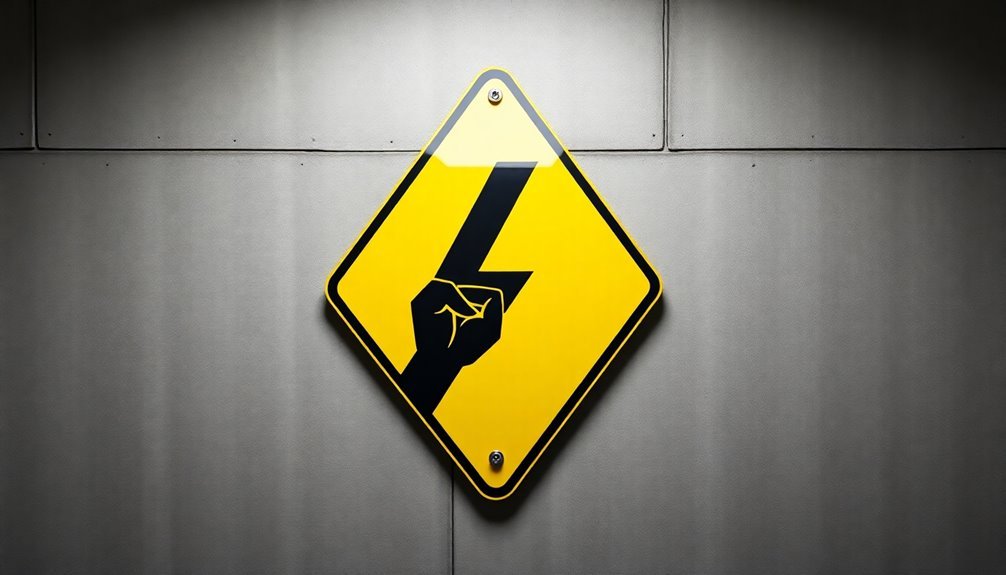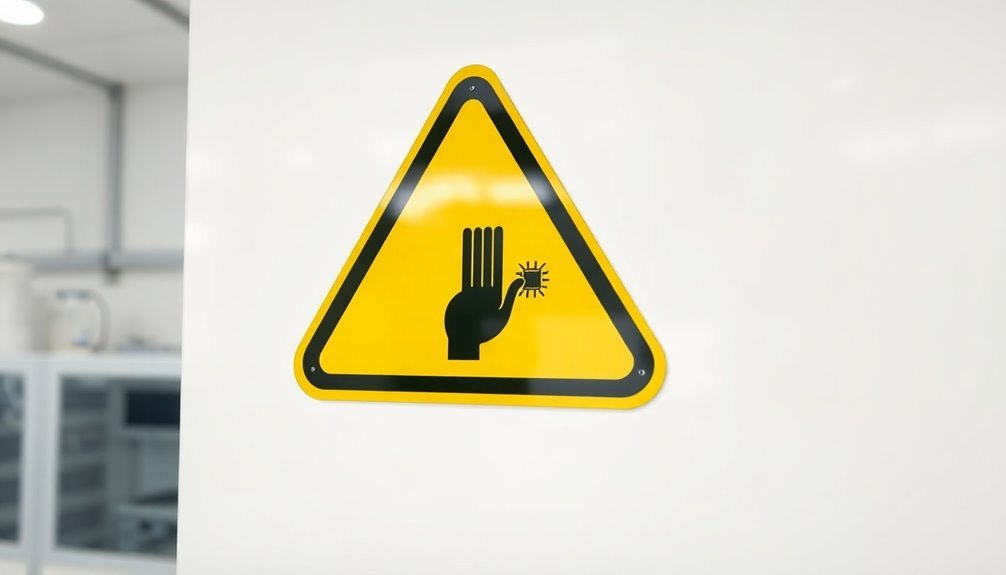You'll need specific warning signs to properly mark static protection areas according to ESD control standards. Place highly visible signs at all entry points and workstations, using the ESD Susceptibility Symbol (yellow hand in black triangle with bar) and ESD Protective Symbol (arc around triangle) on yellow backgrounds with black text. Your signs must be readable from three feet away and clearly state "ATTENTION STATIC CONTROL AREA – ESD PROTECTION REQUIRED." Don't use red coloring, as it implies personnel hazards. Choose durable materials like rigid plastic or aluminum for long-lasting visibility. Understanding proper sign placement and maintenance is essential for maintaining an effective ESD control program.
Regulatory Standards for ESD Signs

When setting up an ESD-protected area, you'll need to follow strict regulatory standards for signage and markings. You must clearly identify these areas using signs, barrier tape, partitions, or rope guards to guarantee proper protection of sensitive electronic components. All marking requirements must be defined in writing according to your ESD Control Program Plan.
You'll notice two main symbols in use: the ESD Susceptibility Symbol and the ESD Protective Symbol. The Susceptibility Symbol features a yellow hand in a black triangle with a bar through it, identifying devices that can be damaged by static discharge.
The Protective Symbol includes an arc around the triangle instead of a slash and indicates items with ESD control properties. You'll see letters under the triangle (L, D, or C) that specify the main ESD control property.
Your signs must be readable from three feet away and use black symbols on yellow backgrounds for maximum contrast. Don't use red in ESD symbols, as it suggests personnel hazard.
You'll need to accompany symbols with text stating "ATTENTION STATIC SENSITIVE DEVICES" and "HANDLE ONLY AT STATIC SAFE WORK STATIONS." For military applications, you'll also need to comply with MIL-STD-129, which requires special marking code "39" for ESDS items.
Essential Warning Sign Placement
Placing warning signs throughout your ESD protected areas demands careful attention to detail and strategic positioning.
You'll need to guarantee that signs are visible from at least three feet away and clearly mark the boundaries where ESD protection begins and ends. It's vital to identify all workstations, packaging areas, and common spaces where ESD-sensitive components are handled. The EPA must maintain the same electrical potential across all surfaces and objects within the protected zone.
Your warning signs must use standard ESD symbols and deliver clear, concise messages about protection requirements. When placing signs, focus on consistent application across all protected areas while avoiding colors that might suggest personnel hazards.
- Place ESD caution signs at every workstation handling sensitive components
- Mark package handling areas with appropriate labels indicating ESD-sensitive contents
- Identify common grounding points with specific symbols for proper procedures
- Post boundary markers using ESD marking tape and signs at all entrances and exits
Remember to integrate your signage placement with your overall ESD control program. You'll want to emphasize safe handling practices and clearly indicate where ESD protective equipment is required.
This thorough approach guarantees that your warning signs effectively communicate safety requirements while maintaining regulatory compliance with standards like ANSI/ESD S20.20.
ESD Sign Design Elements

The key design elements of ESD warning signs must follow strict industry standards while maintaining clear visual communication. You'll need to guarantee your signs use contrasting colors, with yellow backgrounds and black lettering being the most common combination.
The ESD Susceptibility Symbol, featuring a hand in a triangle with a slash, should be clearly visible from at least three feet away. Continuous monitoring of sign visibility and placement helps maintain effective ESD control across the facility.
When designing your ESD signs, you'll want to avoid using red, as it implies immediate hazard rather than caution. Your signs should incorporate text that clearly indicates ESD protection requirements, such as "ATTENTION STATIC CONTROL AREA ESD PROTECTION REQUIRED." Remember that these design specifications are outlined in ANSI/ESD S8.1 guidelines.
You must also consider specific versions of the ESD Susceptibility Symbol if you're working with JEDEC or military applications. Your ESD Control Program Plan should define marking requirements based on customer contracts and purchase orders.
To maintain compliance with ANSI/ESD S20.20 standards, you'll need to guarantee all ESDS items are properly marked according to documentation requirements, making the design elements both recognizable and standardized across your facility.
Multilingual Warning Sign Requirements
Modern facilities with diverse workforces must implement multilingual warning signs in static protection areas to guarantee thorough safety communication. You'll need to confirm that all personnel, regardless of their primary language, can understand and follow static protection protocols effectively. This requirement aligns with OSHA regulations and ANSI/ESD standards for clear hazard communication.
When implementing multilingual warning signs, you should assess your facility's linguistic makeup and select appropriate signage that includes both English and prevalent secondary languages. Your signs must effectively communicate static protection requirements while meeting regulatory compliance standards. Signs constructed with industrial-strength materials ensure long-term durability in static protection environments.
Key considerations for multilingual ESD warning signs include:
- Assessment of your workforce's language demographics to determine necessary translations
- Selection of bilingual or multilingual signs that maintain clarity and visibility
- Regular evaluation of signage effectiveness through employee feedback
- Customization options to address specific facility requirements
You'll need to review and update your multilingual signage regularly to confirm ongoing effectiveness. This proactive approach helps reduce liability, prevent accidents, and maintain a safe working environment while meeting regulatory requirements for static protection areas.
Regular evaluation and updates are crucial as they ensure that the signage remains effective and relevant. This includes considering feedback from employees to make any necessary adjustments to the signs.
Material Selection for ESD Signs

When choosing materials for your ESD warning signs, you'll need to weigh the benefits of rigid plastic signs against flexible vinyl options.
Rigid plastic signs offer superior durability for high-traffic areas. They are typically 1mm thick and hold up better in outdoor conditions, withstanding repeated cleaning and harsh environmental conditions such as rain and sunlight without fading or deteriorating. The signs must display clear contrast lettering as specified in ESD labeling guidelines.
Flexible vinyl signs, on the other hand, work well for curved surfaces and excel in indoor environments with controlled conditions. They have a gloss finish with a permanent adhesive backing for quick and easy fixing, but are mainly suited for indoor use, although they can be used outdoors if provided with cover or shelter.
Material selection should align with standardized durability testing requirements, ensuring your signs maintain visibility and effectiveness throughout their intended service life. For example, plastic signs are resilient and can withstand various environmental conditions, making them a versatile choice for both indoor and outdoor applications. Aluminum signs, while more durable and resistant to weather and UV rays, offer a professional appearance but are generally more expensive.
In terms of specific applications:
- Rigid Plastic Signs:
- Used extensively across safety sign ranges.
- Suitable for use indoors and outdoors.
- Durable and long-lasting.
- Easily punched or drilled and easy to fix with adhesive tabs or no nails grab adhesive.
- Weather and UV resistant.
- Flexible Vinyl Signs:
- The most economical sign material.
- Gloss finish with a permanent adhesive backing for quick and easy fixing.
- Mainly for use indoors, but can be used in outdoor situations that provide cover or shelter.
- For best results, apply to clean, dry surfaces.
Rigid Vs Flexible Signs
Selecting appropriate materials for ESD warning signs involves choosing between rigid and flexible options, each offering distinct advantages for different applications.
When you're setting up your static protection area, you'll need to think about the environmental conditions, installation requirements, and budget constraints to make the best choice.
Rigid signs, made from materials like aluminum or rigid plastic, offer superior durability and weather resistance. They're ideal for permanent installations and outdoor environments where signs must withstand UV exposure and harsh conditions. While they're more expensive, their longevity often justifies the initial investment. These signs can effectively withstand temperatures from -40 to +180 F.
Flexible vinyl signs with self-adhesive backing provide a cost-effective alternative that's particularly suitable for indoor applications. You'll find them easier to install, and they can conform to various surface types without requiring mounting hardware.
- Rigid signs excel in high-traffic areas where durability is essential
- Flexible signs are perfect for temporary installations or when frequent updates are needed
- Choose rigid options for outdoor exposure and harsh environments
- Opt for flexible signs when budget constraints are a primary concern
Think about your specific needs in regard to placement, longevity, and installation requirements when making your final selection between rigid and flexible ESD warning signs.
Durability Testing Standards
Every ESD warning sign must undergo rigorous durability testing to meet ANSI ESD S20.20 compliance standards. You'll find that these signs are tested across three critical durability aspects: water resistance, chemical resistance, and adhesive strength. Each component plays a crucial role in guaranteeing long-term functionality in protected areas.
When you're selecting ESD warning signs, you'll notice they're coated with specialized water-resistant materials that maintain visibility even after exposure to moisture. The signs' chemical-resistant coating protects against common industrial substances like grease and oils, preventing degradation in harsh environments. The width of 11 inches provides optimal visibility for personnel entering protected areas.
You won't need to worry about specific material types, as the emphasis is on performance rather than composition.
The self-adhesive backing undergoes testing to verify its staying power. While there's no specific adhesive strength requirement, you can expect the peel-and-stick mechanism to provide reliable, long-term attachment.
The signs' durability testing guarantees they'll maintain their effectiveness throughout their service life, meeting all ESD control standards for marking requirements. You'll find these signs are thoroughly evaluated to withstand the demanding conditions of static-protected environments while maintaining clear visibility and essential warning messages.
Sign Visibility and Maintenance
Throughout daily operations in static protection areas, proper sign visibility and maintenance play a crucial role in preventing ESD damage. You'll need to guarantee all signs provide clear lines of sight and use contrasting backgrounds, such as black triangles on yellow or orange backgrounds, for maximum visibility. Avoid using red in your ESD symbols, as this color typically indicates personnel hazards rather than static protection warnings.
Regular maintenance of your signage system isn't just about visual checks – it's an exhaustive process that includes documented inspections and immediate replacement of damaged signs. You'll want to incorporate these checks into your company's compliance verification plan while maintaining detailed records of all maintenance activities.
Key aspects of sign visibility and maintenance include:
- Conducting regular resistance measurements of worksurfaces (Rp-p and Rg)
- Guaranteeing signs are sized appropriately for viewing from necessary distances
- Maintaining proper humidity levels between 30-70% in protected areas
- Verifying that all grounding points are clearly marked and accessible
Remember to integrate sign maintenance protocols into your employee training programs and keep all related documentation for at least three years to maintain compliance with industry standards.
EPA Entry Point Signage

Clear signage at EPA entry points serves as your first line of defense against ESD damage. While the EPA doesn't provide specific guidelines for ESD protection area signage, you'll need to implement effective warning systems based on industry best practices.
Your signs should clearly communicate the area's purpose and entry requirements, particularly focusing on proper ESD protection gear.
You'll want to include key information about grounding requirements and equal potential maintenance on your entry point signs. Consider incorporating static control warning symbols and listing the types of ESD-sensitive devices present in the area.
If you're using access control systems like swipe cards or door locks, make sure your signage explains these procedures.
Remember that while EPA regulations don't specifically address ESD signage requirements, you're still responsible for following industry standards like CLC/TR 61340-5-2:2008 for protected areas.
Your signs should emphasize the mandatory use of equipment such as wristbands, coiled cords, and ESD working surface mats. Don't forget to include information about required training for personnel entering the area and the importance of maintaining ESD protection equipment.
Warning Symbol Guidelines
Building on proper EPA entry signage, understanding warning symbol guidelines guarantees consistent communication of ESD risks and controls throughout your facility.
You'll need to implement two primary symbols: the ESD Susceptibility Symbol (featuring a yellow hand deleted by a bar in a black triangle) and the ESD Protective Symbol (showing a triangle with a reaching hand and arc).
When placing these symbols, you'll want to guarantee they're highly visible and readable from at least three feet away. Use a yellow hand on a black triangle or a black symbol on yellow background for maximum contrast, but never use red as it suggests personnel hazards. Always accompany symbols with clear text identification.
Key requirements for ESD warning symbols include:
- Placement at EPA boundaries and workstations to create a definite link between the message and hazard
- Consistency in design across all applications to prevent confusion
- Proper use of Common Ground Point Symbols to identify grounding locations
- Inclusion of specific ESD control properties (L, D, C) under the triangle when applicable
Remember to download standard symbols from the ESD Association at no charge to maintain uniformity throughout your facility.
Sign Testing and Inspection

Regular testing and inspection of your ESD warning signs guarantee they remain effective at communicating critical safety protocols.
You'll need to conduct visual inspections daily to check for wear and tear, ensuring signs are legible and properly secured.
Weekly evaluations should focus on reviewing signs for any updates in ESD protocols,
while monthly examinations require detailed inspection for damage that could affect visibility.
Your testing criteria must address five key factors: legibility, durability, compliance, visibility, and maintainability. You should verify that text and symbols remain clear and easily readable, while also evaluating the sign's material condition and resistance to wear.
When conducting inspections, you'll need to document all findings and maintain accurate records of maintenance activities.
Ensure you're following proper maintenance procedures by cleaning signs regularly to prevent dust buildup and replacing damaged ones promptly. Don't forget to store spare signs in a clean, dry environment.
During quarterly evaluations, verify that all signs comply with current ESD standards, and complete thorough annual audits to maintain regulatory compliance.
If you spot any signs that aren't adequately lit or properly mounted, take immediate corrective action.
Text Requirements for ESD Signs
Proper text formatting on ESD warning signs guarantees critical safety information remains clear and actionable. You'll need to verify your signs display "ESD HANDLING IS REQUIRED" and include the ESD Susceptibility Symbol, especially at protected area boundaries and workstations.
The text must be readable from at least three feet away, typically using black lettering on a yellow background for maximum contrast.
For ESD packaging labels, you're required to include clear warnings about handling procedures. Your labels must indicate that packages should only be opened in ESD protected areas and must feature the ESD symbol to identify sensitive devices inside.
- Unit pack labels need "ATTENTION STATIC SENSITIVE DEVICES" and "HANDLE ONLY AT STATIC SAFE WORK STATIONS"
- Intermediate container labels require a 2×2-inch black-on-yellow format
- Exterior container labels must use a 4×4-inch black-on-yellow format
- Military applications must follow MIL-STD-129P specifications with the EIA-471 symbol
You'll need to comply with ANSI/ESD S20.20 standards while verifying all text requirements align with your customer contracts and purchase orders. Remember that proper text visibility and formatting aren't just about compliance—they're essential for protecting sensitive electronic components.
ESD Sign Mounting Methods

When you're planning to install ESD warning signs, you'll need to think about three primary mounting options.
Secure wall installations provide permanent visibility, while floor stands offer flexibility for repositioning signs in dynamic work environments.
For larger facilities, suspended ceiling mounts let you maximize visibility across open areas while keeping walkways and work surfaces clear.
Secure Wall Installation Methods
Successful ESD sign installation depends on choosing the right mounting method for your facility's surfaces and conditions. You'll find that industrial-grade materials and proper installation techniques guarantee your ESD warning signs remain securely in place while maintaining their visibility and effectiveness.
When you're installing signs on walls, it's vital to consider the surface type and environmental factors that might affect adhesion.
For the best wall mounting results, you'll want to choose from these proven installation methods:
- Use peel-and-stick applications on clean, smooth surfaces where chemical exposure is minimal and quick installation is needed
- Select pre-mounted signs with industrial-grade adhesives for areas exposed to harsh conditions or frequent cleaning
- Install magnetic signs on metal surfaces when you need the flexibility to relocate warnings or temporarily remove them
- Apply mounted signs with proper hardware for permanent installations in high-traffic areas
Before installation, verify that your chosen method meets your facility's specific requirements for chemical resistance and durability. If you're working with unique surface conditions, you can take advantage of professional design assistance to determine the most secure mounting solution.
Remember that proper installation is critical for maintaining OSHA compliance and guaranteeing effective ESD protection throughout your facility.
Floor Stand Sign Options
Floor stand signs stand out as a versatile mounting solution for ESD warning areas, giving you the flexibility to position critical safety information exactly where it's needed. You'll find these signs particularly effective at entry points and high-traffic areas where visibility is essential for maintaining ESD protocols.
When selecting floor stand options, you'll want to think about signs made of industrial-grade materials that can withstand your facility's environment. Look for UV-resistant and chemical-resistant options that you can easily clean with water or mild detergent.
You can choose from various sizes to match your space requirements, and many manufacturers offer customization options to meet your specific facility needs.
To guarantee compliance, select floor stands that display OSHA-compliant headings and symbols. You'll find signs available in convenient multi-pack options through online resellers, with specific part numbers for easy reordering.
When implementing floor stand signs, integrate them with your existing ESD flooring system and 5S program. They should clearly communicate static-free zones and proper grounding requirements while complementing your overall safety communication strategy.
Suspended Ceiling Mounting Tips
Suspended ceiling mounting offers distinct advantages for ESD warning signs in facilities with high ceilings or open spaces. When you're installing signs in these areas, you'll need to carefully consider the pendant length and mounting hardware to guarantee optimal visibility and safety.
Using adjustable pendant kits, you can position your signs at the recommended 7-8 feet height while maintaining clear sightlines throughout your facility.
For secure installation in suspended ceilings, you'll want to focus on these key aspects:
- Use ceiling brackets or drop rods designed specifically for ESD signs to guarantee stability and prevent unwanted movement
- Center your signs directly above exit pathways while maintaining proper clearance for foot traffic below
- Select durable mounting materials that comply with ESD sign regulations and can withstand your facility's environmental conditions
- Install adjustable pendant systems that allow for future height modifications if needed
When mounting to suspended ceilings, you can improve installation safety by using extension poles instead of ladders. Specialized ceiling clips and sign hanging systems like LoopLine will help guarantee your signs hang evenly and securely.
Remember to verify that your chosen mounting method doesn't interfere with existing ceiling fixtures or obstruct emergency systems.
Frequently Asked Questions
How Often Should ESD Warning Signs Be Replaced Due to Normal Wear?
You should replace ESD warning signs when they show visible wear, damage, or reduced readability. Inspect signs monthly and replace them immediately if they're peeling, faded, or hard to read to maintain safety compliance.
Can Temporary ESD Warning Signs Be Used During Facility Renovations?
Yes, you can use temporary ESD warning signs during renovations. They're designed with durable materials and peel-and-stick applications that make them perfect for short-term use while maintaining compliance with safety standards.
Are Illuminated ESD Warning Signs Recommended for Low-Light Industrial Environments?
Yes, you'll definitely want illuminated ESD warning signs in low-light industrial environments. They're essential for ensuring worker visibility, maintaining safety awareness, and preventing costly ESD-related accidents during all lighting conditions.
What Are the Specific Color Requirements for Colorblind Accessibility?
You'll need to use high-contrast color pairs like blue-red or blue-orange, avoid red-green combinations, and include clear symbols. Don't rely on color alone – add thick lines and bold text for clarity.
Do Mobile ESD Workstations Require the Same Warning Signage as Fixed Locations?
Yes, you'll need the same warning signs for mobile ESD workstations as fixed ones. While your signs may need to be portable, they must still meet all OSHA compliance requirements and display proper ESD symbols.
In Summary
You'll need to maintain your ESD warning signs according to industry standards and regularly inspect them for compliance. Remember to update multilingual text when needed, verify proper mounting heights and locations, and guarantee all symbols remain clearly visible. Don't forget to document your sign inspections and replace any damaged or faded signs immediately to maintain workplace safety and regulatory compliance.





Leave a Reply